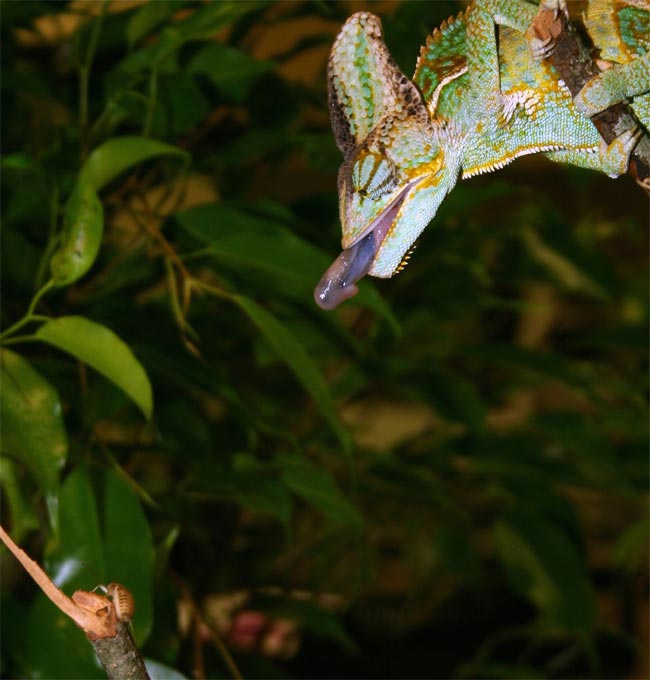Chilled Chameleons Still Quick to Snag a Meal

Chameleons' high-speed tongues can still shoot out lickety-split to capture prey in cold temperatures, when their other muscles don't move as fast, a new study finds.
As a result, the reptiles can keep chowing down across a range of temperatures, regardless of how fast the rest of their bodies move.
Since these cold-blooded creatures, or ectotherms, rely on heat from the surrounding environment to warm their bodies, their muscles can't function as well when it's chilly outside.
Why doesn't the tongue also succumb to the cold? It's powered by a special mechanism, one that separates the tongue's projectile-like motion from direct muscle contraction, and allows it to accelerate at 41 Gs, said Christopher Anderson, a researcher at the University of South Florida. One G is the normal force of gravity. An astronaut feels about 3.5 Gs during a space shuttle liftoff. A mere 8 Gs will cause most people to black out.
Until now, scientists thought the main advantage of this tongue mechanism over muscle contraction was just for speed. But the new study shows it has cold-weather benefits as well, Anderson said.
And humans could perhaps use a similar design for devices that need to maintain their performance in low temperatures, such as prosthetic limbs and sports equipment, he said.
Ballistic tongues
Get the world’s most fascinating discoveries delivered straight to your inbox.
Colder temperatures can have a considerable impact on lizards and other ectotherms, affecting their ability to gather food and flee predators. In fact, a 10-degree drop has been shown to reduce speeds in lizards and fish, and jumping distances in frogs by at least one-third, the researchers say.
But chameleons maintain their ability to feed across the range of temperatures in their habitat, from 38.3 degrees Fahrenheit (3.5 degrees Celsius) in mountain areas to above 100 degrees F (39 degrees C) in the desert.
Chameleons owe this ability to their unique tongues, which are launched via a stretch-and-release mechanism, similar to that of a bow and arrow. First, a muscle gradually contracts and stretches elastic tissue in the tongue, which stores up energy. Then, at the right moment, this energy is released, allowing the tongue to reach the prey in about 70 milliseconds, or about five times faster than the average eye-blink.
At lower temperatures, the muscle contracts more slowly, but this doesn't affect how much energy is stored in the elastic tongue tissue.
"It's like shooting a bow and arrow," Anderson said. "It doesn’t matter how slowly you pull the bow back…the same amount of energy is going to be released."
Bringing the tongue back into the mouth does require direct muscle movement. These two different mechanisms allowed the researchers to test whether the stretch-and-release system really is more resistant to the cold than muscle-powered movements.
Cold-proof
They compared the performance of tongue projection versus retraction at 59 degrees F (15 degrees C), 77 degrees F (25 degrees C) and 95 F (35 degrees C).
A 10-degree-Celsius drop caused more than a 42 percent decrease in the tongue's retraction speed. But the same temperature decrease caused only a 10 percent to 19 percent drop in the speed and power of the tongue's projection.
Other animals, such as frogs and salamanders, might also use this elastic mechanism, because of its ability to withstand low temperatures, Anderson said.
The results were published this week in the journal Proceedings of the National Academy of Sciences.
- The World's Most Explosive Tongue
- Chameleons: Masters of Disguise or Display?
- Image Gallery: Snakes, Frogs and Lizards

Rachael is a Live Science contributor, and was a former channel editor and senior writer for Live Science between 2010 and 2022. She has a master's degree in journalism from New York University's Science, Health and Environmental Reporting Program. She also holds a B.S. in molecular biology and an M.S. in biology from the University of California, San Diego. Her work has appeared in Scienceline, The Washington Post and Scientific American.


